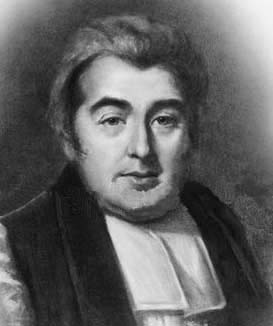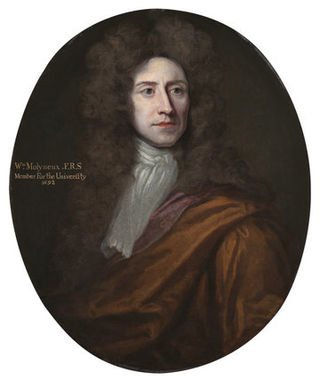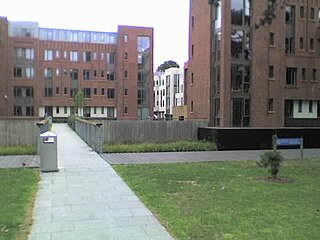
Abraham Stoker was an Irish author who is best known for writing the 1897 Gothic horror novel Dracula. During his lifetime, he was better known as the personal assistant of actor Sir Henry Irving and business manager of the West End's Lyceum Theatre, which Irving owned.

Trinity College Dublin, officially The College of the Holy and Undivided Trinity of Queen Elizabeth near Dublin, is the sole constituent college of the University of Dublin, Ireland. Founded in early 1592 by Queen Elizabeth I who issued a royal charter, it is Ireland's oldest university and was modelled after the collegiate universities of both Oxford and Cambridge. The terms "Trinity College" and "University of Dublin" are synonymous for administrative purposes, as only one such college was ever established.

John Mortimer Brinkley was the first Royal Astronomer of Ireland and later Bishop of Cloyne. He was President of the Royal Irish Academy (1822–35), President of the Royal Astronomical Society (1831–33). He was awarded the Cunningham Medal in 1818, and the Copley Medal in 1824.
William Wilkins was an English architect, classical scholar and archaeologist. He designed the National Gallery and University College London, and buildings for several Cambridge colleges.

The College Historical Society (CHS) – popularly referred to as The Hist – is a debating society at Trinity College Dublin. It was established within the college in 1770 and was inspired by the club formed by the philosopher Edmund Burke during his own time in Trinity in 1747. It holds the Guinness World Record as the "world's oldest student society".
The University Philosophical Society, commonly known as The Phil, is a student paper-reading and debating society in Trinity College, Dublin, Ireland. Founded in 1683 it describes itself as the oldest student, collegial and paper-reading society in the world.

St Patrick's, Carlow College, is a liberal arts college located in Carlow, Ireland. The college is the second oldest third level institution in Ireland and was founded in 1782 by James Keefe, then Roman Catholic Bishop of Kildare and Leighlin, and his co-adjutor bishop Daniel Delany.

Trinity University College was a Church University College in Carmarthen, Wales.

The Dublin Philosophical Society was founded in 1683 by William Molyneux with the assistance of his brother Sir Thomas Molyneux and the future Provost and Bishop St George Ashe. It was intended to be the equivalent of the Royal Society in London as well as the Philosophical Society at the University of Oxford. Whilst it had a sometimes close connection with the Royal College of Physicians of Ireland, its closest institutional connection was with Trinity College Dublin.

Trinity Hall is the main extramural hall of residence for students of Trinity College in Dublin, Ireland. It is located on Dartry Road in the Dartry neighbourhood, part of the affluent suburb of Rathmines and about 4 kilometres south of the College's main campus. Trinity's Botanic Gardens share the site. Trinity Hall is linked to the city centre campus by direct Dublin Bus route and the Luas light rail system via the Milltown Luas stop.

The College of Arts and Letters is the oldest and largest college within the University of Notre Dame. The Dean of the College of Arts and Letters is Sarah Mustillo.
Summit Pacific College is an undergraduate and postgraduate Bible college and seminary, on a foothill of Sumas Mountain in Abbotsford, British Columbia, Canada. It is accredited by the Association for Biblical Higher Education and is the theological college of the BC & Yukon District of the Pentecostal Assemblies of Canada.
Robert Brendan McDowell was an Irish historian. He was a Fellow Emeritus and a former Associate Professor of History at Trinity College Dublin. He was born in Belfast. He was referred to colloquially as "RB", "McDowell" or "the White Rabbit". His politics were strongly Unionist and he was a member of the British Conservative Party.
The Milltown Institute of Theology and Philosophy was a Jesuit-run institution of higher education and research, located in Dublin, Ireland. It was located in Ranelagh, County Dublin.

The Library of Trinity College Dublin serves Trinity College. It is a legal deposit or "copyright library", under which, publishers in Ireland must deposit a copy of all their publications there, without charge. It is the only Irish library to hold such rights for works published in the United Kingdom.
William de Burgh was a prominent Anglo-Irish politician and theological writer who was a Member of Parliament for Athy (1769–76), a supporter of William Wilberforce, and an active campaigner for the abolition of slavery.

Colonel Thomas de Burgh, always named in his lifetime as Thomas Burgh, was an Anglo-Irish military engineer, architect, and Member of the Parliament of Ireland who served as Surveyor General of Ireland (1700–1730) and designed a number of the large public buildings of Dublin including the old Custom House (1704–6), Trinity College Library (1712–33), Dr Steevens' Hospital (1719), the Linen Hall (1722), and the Royal Barracks.

The Laurentian Society is a society of Trinity College Dublin, named after Saint Laurence O'Toole, and concerned with relevant issues from a Catholic perspective. It was the Catholic society of Trinity College, and it existed with no interruptions between the academic years 1952–53 and 2001–02. During those years, the society held talks on various issues and was engaged in charitable activities. The society played a role in opposing the ban on Catholics entering Trinity College, and was also influential on other groups of the college, such as the G.A.A. club of Trinity. In September 2011, the society was revived, being granted provisional recognition by the Trinity College Central Societies Committee. The revived society was granted full recognition on 19 March 2013 at the Annual General Meeting of the same Societies Committee.

The Rubrics is the oldest building within Trinity College Dublin. Although the exact date is unknown, it was designed and built in c.1700. Today, the Rubrics are used as rooms for students and fellows.
















